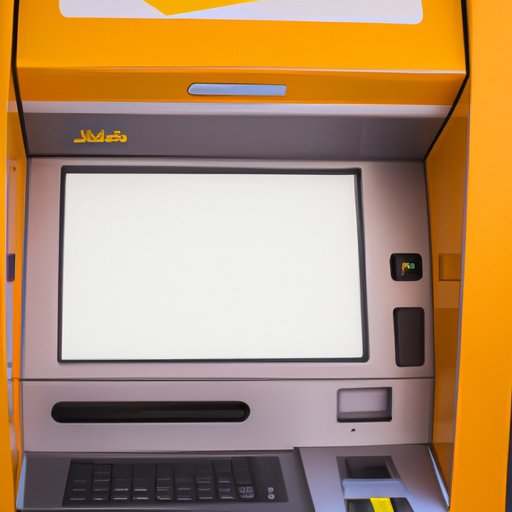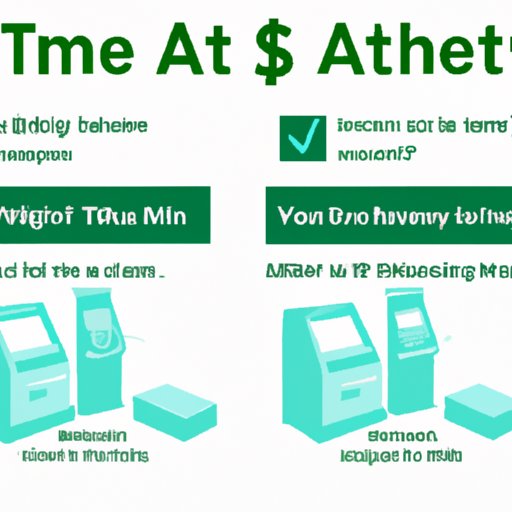
Introduction
Cashing a check can be a hassle, especially with traditional methods that require a visit to a bank or check-cashing store. Fortunately, technology has made things easier. ATMs, in particular, have made it possible to cash checks without a teller’s assistance. But can you cash a check at an ATM? In this article, we provide a comprehensive guide to cashing your check at the ATM.
5 Simple Steps to Cashing Your Check at the ATM
Before attempting to cash your check at an ATM, it is essential to note that the process may vary depending on the bank or ATM you use. However, most ATMs usually have similar functions. Below are the common steps involved in cashing a check at the ATM:
- Insert your ATM card and enter your PIN.
- Select “Deposit” or “Cash” to cash the check.
- Enter the check amount and verify the details.
- Insert the check into the ATM, and wait for it to verify the funds.
- Take your cash and receipt from the ATM.
Cashing your check at the ATM has several advantages:
- It is a convenient option that saves time from having to go to a bank or check-cashing store.
- ATMs are usually available 24/7, making it possible to cash a check at any time of the day.
- The process is relatively fast, and you can receive your cash within minutes after verification.

Pros and Cons of Cashing Your Check at the ATM
Cashing your check at the ATM has its advantages and disadvantages. Here are some pros and cons to consider:
Pros of Cashing Your Check at the ATM
- You get your cash faster than waiting in line at a bank.
- ATMs provide greater privacy than tellers.
- ATMs are open 24/7, making it more convenient to cash a check any time.
Cons of Cashing Your Check at the ATM
- ATM cash limits may be lower than what you need, which may require multiple transactions.
- The ATM may only accept certain types of checks, which may limit you to just cashing checks from the issuing bank.
- ATMs can be costly, with fees that may be higher than cashing a check at a bank or check-cashing store.
ATM Check Cashing: A Quick Guide for Beginners
ATM check cashing is a process where you can cash your check without the need to visit a bank or check-cashing store. The types of checks that can be cashed at an ATM are payroll, tax refund, cashier’s, and government checks. However, third-party checks and personal checks may not be accepted.
ATMs have limits on the amounts that you can cash. The limits may differ from bank to bank, or from ATM to ATM. Some may only allow you to cash up to $500, while others may allow up to $10,000.
Avoiding Common Mistakes When Cashing Your Check at the ATM
When cashing your check at the ATM, there are common mistakes to avoid to ensure a smooth transaction. These mistakes include:
- Failing to endorse the check properly can cause delays or a rejected transaction.
- Not verifying the check amounts before inserting them into the ATM can result in incorrect deposits or rejected transactions.
- Not verifying the ATM’s cash limits can cause a rejected transaction or multiple transactions.
- Forgetting to take your cash or receipt can lead to lost funds or disputed transactions.
It is essential to follow these tips to ensure a smooth transaction:
- Endorse your check correctly, using your signature, account number, and “For Deposit Only.”
- Verify the check amount to avoid entering the wrong information.
- Verify the ATM’s cash limits and ensure that the amount you need can be cashed in a single transaction.
- Take your cash and receipt and keep it in a secure place.
Maximizing Convenience: Why Cashing Your Check at the ATM Makes Sense
Cashing your check at the ATM makes sense due to its multiple advantages over traditional check cashing methods:
- You can cash your check at your convenience, any time of day or night, making it an ideal option for those with busy schedules.
- You can avoid long lines at banks and check-cashing stores, saving time and energy.
- ATMs are widely available in many locations, providing greater accessibility to cash your checks.
- Cashing your checks at an ATM can be much cheaper than using a check-cashing store.
Cashing your checks at an ATM, when compared to other check cashing options, is usually faster, more private, and more convenient.
An Insider’s Perspective: A Bank Teller’s Guide to ATM Check Cashing
According to a bank teller, ATM check cashing is relatively safe and convenient. The teller recommends that you avoid entering the wrong check amounts, as this can cause delays or rejected transactions. The teller also suggests using ATMs that belong to your bank to ensure lower fees and higher deposit limits.
Insider tips for maximizing your experience include:
- Use the same bank’s ATM to avoid extra fees.
- Endorse checks on-site to avoid errors and security violations.
- Check the ATM’s cash limits to avoid multiple transactions.
- Always take your cash and receipt to keep accurate records.
Understanding the Fees Involved in Cashing Your Check at the ATM
Fees associated with ATM check cashing may vary from one bank to another or from one ATM to another. While some banks charge no fees for their ATM transactions, others may charge a nominal fee. However, using your bank’s ATM is usually the cheapest option.
Some banks may charge foreign ATM fees or surcharges, which increase the transaction’s cost. Moreover, some banks may charge fees for check cashing, and these fees may be higher than those of a traditional bank. To avoid these fees, use the ATM located inside the bank where your account is held.
Conclusion
Cashing your checks at an ATM is convenient, fast, and easy. However, you need to be aware of the fees involved, cash limits, types of checks accepted, and common mistakes to avoid. By following the steps provided in this article, you can successfully cash your checks at the ATM without any issues. Consider ATM check cashing as a viable option in your future financial transactions.





